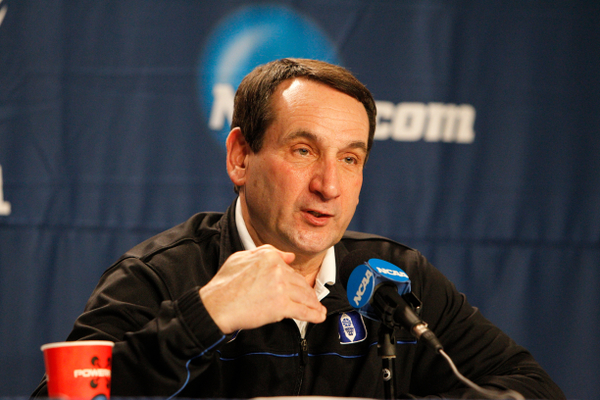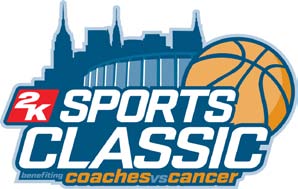
Andrew Murawa is the RTC correspondent for the Pac-10 and Mountain West Conferences and an occasional contributor.
To read the entire In Their Words series, click here.
Part Five: SCHEDULING
Over the summer, we’ve spent time hearing about some of the next big-name recruits on their way to college basketball: Jared Sullinger and Harrison Barnes, Anthony Davis and Michael Gilchrist. We’ve heard the big-time schools announce their high profile games on their upcoming schedules: Kentucky going to the Maui Invitational and visiting North Carolina, Michigan State hosting Texas and going to Duke. But for the vast majority of Division I programs, they’ve been flying under the radar. There are at present 73 teams that participate in basketball in the six BCS conferences, but there are 347 total programs in Division I. Of those other 274 programs, there are certainly quite a few big-name programs: last year’s national runner-up Butler comes to mind immediately, as does Gonzaga, Memphis and a handful of other schools in conferences like the Atlantic 10 and the Mountain West. But, we were also interested in how the other half (or really, how the other three-quarters) lives, so we spent some time talking to coaches, athletic directors and other people around the country affiliated with some of those other schools — those non-BCS schools, those “mid-majors” — and we asked them about how they recruit, how they create a schedule, how they market their programs, and quite a few other things. Over the next eight weeks, we’ll let them tell you their story, in their own words.
To begin, let me introduce and thank this week’s cast of characters:
- Eric Brown, Assistant Coach, Long Beach State – Brown enters his fifth year as an assistant on head coach Dan Monson’s staff, after previously having spent time on coaching staffs at Cal-State Northridge, USC and Iowa State.
- Dale Layer, Head Coach, Liberty – Layer enters his second season at Liberty after having spent a season as an assistant at the university in 2007-08. In between, he spent a year at Marquette and previously he spent seven seasons as the head coach at Colorado State. He has compiled a 118-122 record in his eight seasons as a Division I head coach.
- George Ivory, Head Coach, Arkansas-Pine Bluff – Ivory enters his third season in Pine Bluff, where he has turned the Golden Lions into winners. UAPB turned around an 0-11 start last season by finishing 18-5 over their last 23 games, winning UAPB’s first SWAC tournament title in 43 years and advancing to the NCAA tournament before losing to eventual national-champion Duke.
- Larry Williams, Athletic Director, Portland: Williams has been the AD at Portland for six years now following a five year stint as the head of licensing and product marketing at his alma mater Notre Dame. Williams was a two-time All-American offensive lineman with the Irish before starting 44 games in the NFL.
- Murry Bartow, Head Coach, East Tennessee State – Bartow is entering his eighth season as the Buccaneers head coach, after having previously succeeded his father Gene Bartow as the head coach at UAB. Bartow has posted a 118-72 record in his years at ETSU and has racked up 241 total wins and four NCAA appearances in his 13 seasons as a head coach.
- Tommy Dempsey, Head Coach, Rider – Dempsey enters his fifth season as the head man at Rider, following two seasons as an assistant. He has compiled an 83-75 record over that time and coached NBA lottery pick Jason Thompson during his time there.
- Gregg Bach, Assistant Athletics Director for Communications, Akron – Bach was named to his current position this past summer after having spent the previous eight years on the media relations staff in the Akron athletic department. His new job makes him the spokesperson of the athletic department.
- Eric Reveno, Head Coach, Portland – Reveno heads into his fifth season at Portland having turned around a program from a team that was 18-45 in his first two seasons to a team on the rise with a 40-24 record over the last two seasons. Reveno spent his previous nine seasons as an assistant at Stanford, his alma mater where he was a Pac-10 Conference All-Academic Team selection as a senior.
- Chris Caputo, Assistant Coach, George Mason – Caputo is entering his sixth season as an assistant coach for the Patriots after spending the previous three seasons as an administrative assistant and video coordinator under head coach Jim Larranaga.
- Jason James, Head Coach, Tennessee-Martin – James enters his second season as the head coach at UT-Martin following eight seasons as an assistant coach there. His first season was rough, to the tune of 4-25, after he was appointed head coach in the wake of scandal with the previous head coach. But James, the recruiter who brought Lester Hudson to UT-Martin, has plans to begin to turn things around this season.
For the most part, our first two articles on scheduling at the mid-major level have talked about the difficulties associated with lining up game. We mentioned that some schools see benefits to playing big-time programs with talented rosters, both in recruiting and in preparing their teams for conference and postseason play. Another benefit to playing these types of games is the money. Very few of the programs at this level have huge athletic budgets, so the money from taking a guarantee game and going on the road to face a bigger school is important not only to the basketball program, but also to the entire athletic department and the university. So while getting a chance for publicity from playing these games is a great incentive, the money associated with them is also a strong enticement.

Guarantee Games Are Not Always Guaranteed
Eric Brown, Assistant Coach, Long Beach State: The Big 12, the ACC, they’re all paying out big guarantees. It all depends on that particular school’s budget – some big schools will pay $55,000 or $60,000 guarantees. You can even get up to $80,000 or $90,000. And the later you wait, if there is a BCS school still looking for games, they may have to raise up the ante, they’ll pay a larger amount than they would have three months earlier.
Dale Layer, Head Coach, Liberty: It’s an important part for most mid-majors. Here at Liberty, the athletic department typically tries to reinvest a lot of that money back into the program, so we’re able to use it in a way that enhances Liberty basketball and the athletic department in ways that everybody can appreciate.
George Ivory, Head Coach, Arkansas-Pine Bluff: We think the money is very important, and the main thing when we play those games, you want to do everything you can to help out within the athletic department and the university. So we don’t have a problem playing guarantees. It’s a great thing for the guys to play that kind of schedule, you’re playing some of the top players in the country, some of the top coaches in the country, so I think it is a great experience for all of us.
Larry Williams, Athletic Director, Portland: We will play guarantee games. At some places there are mandates where you’ve gotta play these many guarantees and earn this much money, but we don’t do that. We’re trying to be very conscious of the growth of our program. And if an appropriate guarantee presents itself, we’re not afraid to play it, because quite frankly, we can win those games too. So, we’ve gotta be conscious of the opportunity to get a win and a paycheck.
Murry Bartow, Head Coach, East Tennessee State: I wouldn’t say we have a mandate. My AD and I have a very good relationship, and I, based on conversations with him, know what he is hoping to get, in terms of number of guarantee games, and know what he is hoping for based on the current budget and the current situation. So he and I sit down and visit and based on those conversations I know what I need to do. The bottom line is, I don’t mind playing those games.
Tommy Dempsey, Head Coach, Rider: You can ask ten different schools about guarantee games and get like five different answers. I don’t have a lot of pressure on me, on our basketball program, to play guarantee games. We do play them, but we don’t play too many of them. Last year for instance, we played one against Mississippi State, this year we play one at Pitt. It does help us with revenues within our athletic department at a school like ours, but fortunately our administration isn’t saying to me, you have to go out and play four guarantee games so that we can fund a different program. You know, I don’t have that pressure on me, I don’t have a certain number of dollars that we have to generate through guarantee games. If I choose to, if I want to maybe buck our RPI up in a year when we think we have a chance to be pretty good, maybe help us with getting into a postseason tournament, I have the opportunity to schedule them if I’d like. But I don’t have pressure from my administration to schedule them to bring in a lot of money, and I think that’s a very good situation to be in, where your program is funded enough that there’s not pressure to go take four losses, just to help out with the budget. And I’m very appreciative that I don’t have to do that.
While road guarantee games are the usual case for mid-major match-ups with BCS conference teams, there are other ways to get matchups with BCS schools in other environments, the most common and a greatly preferred way, is in the early-season tournaments like the NIT Season Tip-Off or the Maui Invitational. These tournaments often (although not always) give mid-major programs a chance to face high-majors on a neutral court.
Read the rest of this entry »



















































